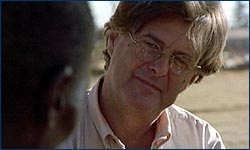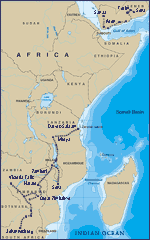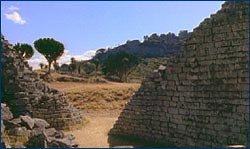 |

|
Once described as "a sort of British Indiana Jones," University of London scholar Tudor Parfitt, in this interview with NOVA producer David Espar, recounts his fascinating odyssey on behalf of the Lemba. A southern African tribe with tantalizing claims to an ancient Jewish heritage, the Lemba dispatched Parfitt on a journey of discovery that would take him halfway across Africa and into a remote desert valley in southern Arabia, where he stumbled upon what he believes may be the lost city of the Lemba. NOVA: How did you come to hear about the Lemba and their story? Parfitt: I first heard about the Lemba when I was in South Africa. I had been asked to give a lecture there on the Ethiopian Jews, the Falashas, because I'd just written a book on the exodus of the Falashas from Ethiopia to Israel. The lecture was mainly attended by white South African Jews, but at the back of the hall I noticed some black people wearing yarmulkes, the Jewish skull cap. That was rather intriguing, so at the end of the lecture I went across to say hello.
They said, "You don't seem to believe what we're saying. Why don't you come spend a weekend with us? We'll show you our fellow Jews and introduce you to our elders, so you'll see that what we're saying is true." So off I went to the northeast corner of South Africa in the area of Venda. And in the course of the weekend, I could see that it was almost certain that they must have some kind of Semitic connection, because all of their pre-modern religious and social practices seemed to be imbued with a quality that was essentially Middle Eastern, essentially Semitic. So I went back to England and, thinking that this would make a great research project, returned the following year and spent many months living with the Lemba in Africa.
Parfitt: It's complicated, because for the last hundred years their oral and other traditions have been contaminated by Western traditions, Western religious practices—in other words, modernization. Now, insofar as one can reconstruct genuine Lemba traditions, what they say essentially is that they came from the North, possibly from Judea. They subsequently went to a place called Sena, then they crossed from Sena to Africa via Pusela. We don't know what that is, and they don't know what that is, but they say, "We crossed Pusela and we came to Africa." Then they say, "We rebuilt Sena, and then we went inland and had something to do with the construction of the Great Stone City [Great Zimbabwe]. At that point, we broke the law of God and we ate mice"—which were not ritually fit for Lemba consumption. And then they were scattered, as they put it, among the nations in Africa. NOVA: So when you went to the Lemba for the first time, what was it that you observed that made you think that maybe there was something to the story of their Semitic roots? Parfitt: I think what really made me feel that there was something to the story, that is to say that there was something Semitic about them, was the amalgam of traditions and perhaps specifically two things. One was the fact that, unlike other tribes, they refused to intermarry and they had a good Semitic disdain for all other people that they referred to as wasenzhi, the gentiles. The other thing was the extraordinary importance they placed upon ritual slaughter of animals, which is not an African thing at all. Of course, it's Islamic as well as Judaic, but it's certainly from the Middle East, it's not African. And the fact that every lad was given a knife with which he did his ritual throughout his life and took to his grave. That seemed to me to be remarkably, tangibly Semitic Middle Eastern.
Parfitt: In the oral history, which is really a rather ambiguous story, they don't know where Sena is. It acts as place of origin but also the place to which they go. They refer to Sena in the same way that we would refer to paradise or heaven. And they say, "We'll meet again in Sena" and things of that sort. It seemed to me that the whole story was magical. Of course, it was a fascinating journey going from village to village, picking up oral traditions from old men and going a little further along the path until finally I was stuck. I got as far as the Indian Ocean, having successfully followed clues across Africa, and then somehow in the Indian Ocean there was nothing. All of a sudden there was just a sea and various ideas floating around in my head. It was only later when I was doing a book on the Jews of the Yemen that I picked up the trail again in southern Arabia. It was a wonderful, wonderful quest and it was very meaningful for me—the whole idea of this terrestrial paradise that they had lost contact with. And I was very moved to be charged with the responsibility of trying to find Sena for them. Continue: Parfitt is chosen Where are the Ten Lost Tribes? | Tudor Parfitt's Remarkable Journey Mystery of Great Zimbabwe | Build a Family Tree | Resources Teacher's Guide | Transcript | Site Map | Lost Tribes of Israel Home Editor's Picks | Previous Sites | Join Us/E-mail | TV/Web Schedule About NOVA | Teachers | Site Map | Shop | Jobs | Search | To print PBS Online | NOVA Online | WGBH © | Updated November 2000 |
 Tudor Parfitt
Tudor Parfitt

 The Lemba believe their ancestors helped build the enigmatic stone city known as Great Zimbabwe.
The Lemba believe their ancestors helped build the enigmatic stone city known as Great Zimbabwe.
 One of the many Lemba customs that Parfitt believes indicate a Middle Eastern ancestry is the ritual slaughter of animals, which is not an African tradition.
One of the many Lemba customs that Parfitt believes indicate a Middle Eastern ancestry is the ritual slaughter of animals, which is not an African tradition.